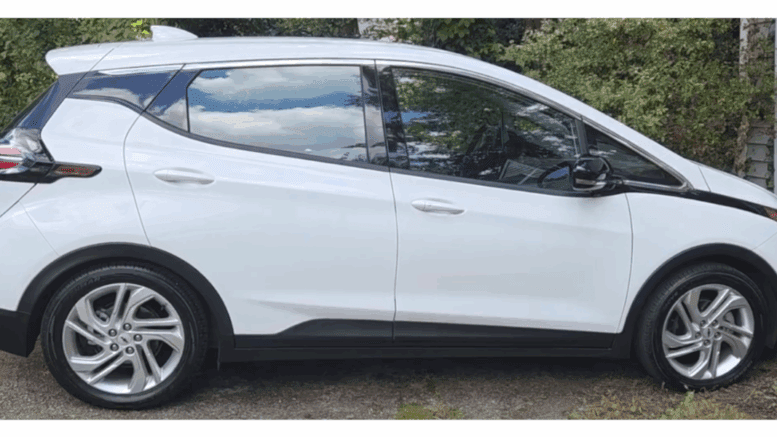By Larry Felton Johnson
A bit over a month ago (in the last week of August 2025), I got a 2023 Chevy Bolt EV, and wrote about it in a previous Publisher’s Soapbox column.
I wrote at that time that I was in the “honeymoon” phase, where the novelty interferes with my ability to look at the experience with a critical eye.
I’m still in that phase and haven’t really found anything yet that I dislike about the car.
One particularly appealing aspect of the car is that I haven’t had to use one of the commercial charging stations, so I’m driving very affordably. I compared the cost of my wife’s car in miles per gallon to what I spend in miles per kilowatt-hour (kWh), and based on my charging method, I’m spending about a quarter of the cost per mile of her 30-mile-per-gallon Honda.
I just plug it in and charge it in the slowest, cheapest way, which is “Level 1” (regular 120-volt household outlet).
That works for me, because the longest distance I travel in a day rarely exceeds 20 miles, and some days the car sits for two days without moving. Nothing conserves fuel like not moving.
Level 1 charging adds 4 to 5 miles of range per hour, which is slow compared to Level 2 (like a household dryer outlet) or DC fast charging (like the commercial chargers), but the speed doesn’t concern me much, since I do it mostly in the 11:30 p.m. to 7 a.m. off-peak hours.
That adds between 30 and 37 miles at the cheapest possible kWh rate. If I drive more than 30 miles during the previous day, I keep the charger plugged in for a longer period. It’s still cheap.
I only charge to 80 percent of the battery capacity, as that preserves battery life, and the zero to 80 percent range charges faster. At 80 to 100 percent battery capacity, the charging speed drops dramatically.
On my Chevy Bolt, 80 percent of the battery capacity translates to approximately 214 miles of driving range. That’s more than enough to support the typical trips I take around Cobb County.
There are always trade-offs
I will include this section every time I write about EVs, as it explains what I view as the advantages and disadvantages of addressing pollution and emission problems by advocating for electric vehicles.
I don’t consider EVs the solution to the history of bad zoning decisions in the U.S. We drive far too much, and our built landscape and transportation policies not only enable that, but in many ways make it necessary.
However, EVs fit nicely into a general hierarchy I’ve developed over my life.
First, it’s better to walk if I can. It’s better for my health, and better for the environment. I was lucky enough to grow up in a time and place where everything I needed was within walking distance (Grant Park in the 1950s and 60s).
A grocery store, barber shop, and pharmacy were on the corner about 100 feet from our front door. My elementary school was three short “city blocks” from our house, and our high school was about five blocks. Our church was across the street from the grocery store I mentioned. Grant Park at that time had a swimming pool, a lake, pavilions, and sports fields. The park was just two short blocks from our house.
Less than three miles away was East Atlanta, at the time a fully functioning business district with two banks, two pharmacies, a movie theater, a public library, a record store, a hobby shop, two supermarkets (smaller than today’s versions, but certainly adequate), a sporting goods/military surplus store, a hardware store, and a post office.
This isn’t just nostalgia on my part. It’s a sign of better urban design, developed in a time when communities were not built around the automobile.
The second part of my hierarchy is to cycle when I can. This extends my realistic errand range by a few miles.
With all that said, I have to navigate a county with wretched public transportation and pedestrian and cycling infrastructure that’s often downright dangerous. So a car is a necessity for me.
Electricity can be produced in a manner that causes significantly less environmental damage than other means of producing energy. Fossil fuels offer limited opportunities for reduced emissions and are, by definition, non-renewable.
Electricity isn’t always produced in the most environmentally friendly way. Still, with modern solar and battery storage technology, it has a potentially much lower carbon footprint and is renewable (a quality that can’t be claimed for any fossil fuel).
So, all things considered, I’m happy with my EV, both in terms of the satisfaction that I’m polluting less than I would with an internal combustion engine and that it’s fun to drive.
Bonus video, an 88-year-old man describes his EV experience
As I obsessively watched videos about the Chevy Bolt, I ran across this gem. It made me feel better about starting my own EV experience at 74 years old.
